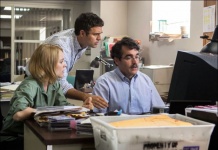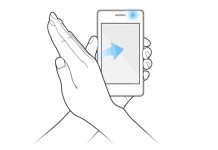 Over at Nieman Reports, assistant editor Jan Gardner has an interview with V. Michael Bove, Jr., a research scientist at the MIT Media Lab. Bove discusses interaction, user participation, and collaboration as components of the future of storytelling.
Over at Nieman Reports, assistant editor Jan Gardner has an interview with V. Michael Bove, Jr., a research scientist at the MIT Media Lab. Bove discusses interaction, user participation, and collaboration as components of the future of storytelling.
The first part of the interview involves an idea for adding more interactivity to televised events by allowing user access to alternate camera feeds using a handheld device. For instance, being able to get a camera shot of the audience at a football game by holding up his iPhone and turning around. While an interesting idea, I couldn’t help being reminded of the full-surround TV screens that the protagonist’s wife bought in Farenheit 451.
But a more interesting part comes later in the article, where Bove talks about interaction in terms of storytelling. Said Bove:
We have to assume the print medium is part of an ecosystem and then ask what happens when all the pieces of the ecosystem fit together. What is the overall experience? This is another issue. Too often in organizations that produce media one team does the main product, another does the Web site, others work on the mobile app, and then there are teams that do something else. That’s unsustainable economically because it’s a huge duplication of effort. It’s also not a particularly good idea in terms of coherence because what you would like is for the experience to play out across these different platforms in different ways and let users go back and forth among them. It’s not necessarily the job of the creators to drive you to a primary platform. I don’t think you can do that anymore. Figuring out how to make it work financially is another matter.
He talked about a TV show on MTV that combined the once-a-week episodes with storytelling on the web so that the viewers would be entertained and be able to watch what was going on during the time the show wasn’t on the air.
Bove notes that some producers and directors have said they should have paid more attention to what fans thought about their shows, because, collectively, there are a lot more man-hours of thought going into the show on the fan side than there are on the writer side, and some of them may have better ideas than the writers do.
The interesting thing to me is that a lot of writers have discovered for themselves how well collaboration and interaction with fans works. I already talked about Elizabeth Bear’s “Shadow Unit” shared universe, and the similarities to the stuff other shared-universe writers had been doing on the Internet since the late ‘80s to early ‘90s.
It seems like a lot of people have discovered independently that collaboration and interactivity is baked into the Internet at a very basic level, due to its decentralized, simple structure.
Just the ability to communicate quickly and easily with anyone practically anywhere revitalized the “collaborating by post” method that writers of old used. And more recently, tools can be built that enable advanced forms of collaboration in real-time, be they EtherPad, Google Wave, or something else altogether.
Interactivity may not be for everybody—there will always be those who just want to read a book or watch a show passively, and not participate in deciding how the story should go. But for creative types who want to take a hand, collaborating with other people is one of the greatest experiences you can have—and it looks as though more people, including research scientists, are finally beginning to realize this.
































